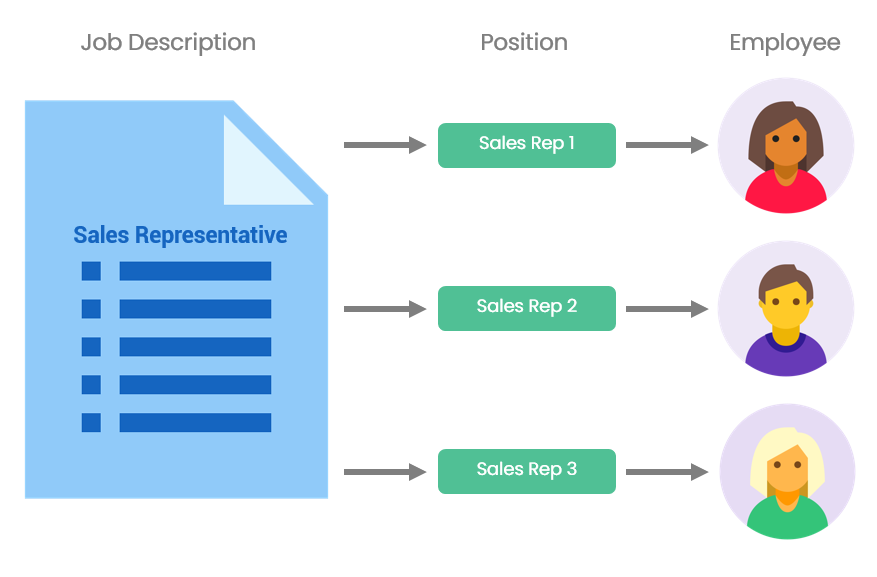What is Job Description Management?
Job description management is a best practice used by companies to streamline and simplify recruiting, hiring, and managing the expectations for...
4 min read
JDXpert : 9/27/21 7:30 AM

Though the terms “job” and “position” are often used interchangeably, there are distinct differences between the two terms in the domain of HR, Talent Management and Compensation.
A job refers to the duties and responsibilities, qualifications competencies of a role within an organization, wherever it exists.
A position is a container for an employee that is attached to a particular job. So if you had 4 individuals in the role of Accountant I (Job) and you had 4 employees in 4 different departments that performed that job, Each employee would be assigned to a position within that job of Accountant.
In a job management model employees are attached directly to jobs:

Job management takes on the task of defining roles in an organization. It is a best practice used by companies to streamline and simplify recruiting, compensation, talent management and managing the expectations of specific roles within the organization.
The job description describes the role, succinctly defining the responsibilities of the role and should include essential functions, compensation, education or certifications needed or physical requirements of the job and the salary ranges. In a job management approach, Job descriptions are kept general enough to describe the role throughout the entire organization. This is also the same for the job component in position management. See Positions Management, below.
Job Description Management is the process and technology used to manage role information and is required whether you are using Job Management or Position management. You might be surprised to know that almost 80% of companies still use Word docs, PDFs, Excel spreadsheets, and shared drives to manage, create, and maintain their job descriptions. Few organizations maintain full and complete job descriptions for all roles, which leads to, difficulty in managing compensation, compliance, talent management and ineffective recruiting processes and, often, bad hiring decisions.
Position management is a way to organize a company’s workforce. Instead of focusing on the individual employee, it assigns employees into positions that can be grouped into departments, locations, shifts etc. The base definition of the position is taken from the job description to which it is attached.

The position defines the chain of command, and various other attributes. Employees in a position will come and go, be promoted, or shift laterally to another positions in other departments.
In some models, positions can be more than just a container for an employee, position descriptions can inherit their base definitions from the job description but also contain additional essential functions or qualifications that result from nuances required by the specific location or department. Let’s say that you have an RN Job in a hospital but an RN in a position in Radiology may require skills and knowledge about radiology equipment and a certification to attest to it. This is a great model to take advantage of the Parent/Child hierarchical structure provided by JDXpert.
Also, in a position control scenario, the position can be the financial basis on which budgeting for employees is controlled. In this case, positions have their own financial value outside the definition of the job. In this case if you wanted to move headcount from accounting to operations it would involve moving a position from under a job in accounting and attaching it to a job in operations.
The job description comes first. Within the job description, you’ll find one or more positions, each a container for the employees who fill those roles.
For example, your job description might outline the expectations, experience, and responsibilities related to a role within the company. There might be several employees whose positions are attributable to one job description. But those individuals can fulfill multiple roles and have multiple positions. This is often the case in healthcare. For example, you might have an Aid that works in one department that is also a sitter in another department or facility.
There is a distinct danger to every position having its own job description or using the terms job management and position management interchangeably.
Doing so may open the door to employees amplifying their job responsibilities in an effort to enhance their position and rationalize a pay increase. Conflating job management and position management alters a job description’s intended purpose from describing what is necessary to succeed in the role throughout an organization to what an individual does in that position.
Fair performance evaluations and pay for performance would be difficult to maintain because you can only compare that employee’s performance to themselves instead of how well they perform the job responsibilities laid out in the job description. It is also harder to qualify internal candidates who would transition well to another job, resulting in the loss of good employees or jobs remaining vacant longer than necessary.
Many times, people think that their HRMS is sufficient to manage their job Information, however, in reality, no HR system supports the granularity of information needed to support the details required to truly manage Jobs and Positions.
Job profiles, in Workday equate to Job Descriptions and maintain the same high-level approach described above under Job Management. If you use positions in Workday, they perform the same function described above under position management, containers for employees under a Job profile.
Job Description Management is much more than a summary of the job or the read-only view of a job description; it’s also the process of keeping the job descriptions accurate and up to date.
Job Description Management allows you to create the job description and also share it with subject-matter experts who can assess the description and add trackable feedback. Those jobs are then easy to access, edit, and transfer through appropriate interfaces to the company’s other HR systems—compensation systems, performance systems, HRMS, Applicant Tracking System (ATS), and others—centralizing and democratizing the information from a single source of truth.
JDXpert is a holistic job description management system that integrates with Workday and most HR management platforms, reducing the chances of disparate systems using inaccurate job data to perform and manage important HR initiatives.
Adding JDXpert job description management to Workday makes managing jobs and positions both simple and highly flexible. Manage your job descriptions in JDXpert, and they sync instantly and seamlessly with your Workday job profiles to reflect accurate, up-to-date job data. If you use position management in Workday, you can use JDXpert to manage the relationship between Job Profiles and positions and automatically cascade appropriate Job data from Jobs to positions and maintain this structure in a highly comprehensive and structured manner.
JDXpert also interfaces with your applicant tracking system and to ensure that the recruiting process leverages the most accurate and up-to-date information available about the role. This provides a solid foundation for hiring well, optimizing pay, and getting the most out of Workday.
If you use Workday and struggle with job profiles or managing positions, JDXpert can help. Check out this video to learn more.

Job description management is a best practice used by companies to streamline and simplify recruiting, hiring, and managing the expectations for...

As an HR professional, you recognize the value of a strong, inspiring job description that reflects the culture, mission and vision of your...

Recent findings from a JDXpert survey highlight a pressing issue in the HR landscape: inefficient job description management. Though employee...